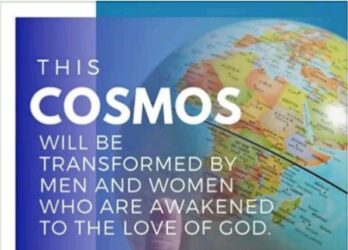PEARLS OF GREAT PRICE CHRIST’S LIFE STUDIES
HAVING THE MIND OF CHRIST: EIKON||CHRISTOLOGICAL ANTHROPOLOGY
APOSTLE GILBERT KARUZA
The answer to the question ‘what is man? ’ is found in the explanation of the Greek term, ‘ eikon’ (image). What is the image of God said to be in man?
The Apostle Paul explains creation from redemption; Adam from Christ, the earthly from the heavenly. What man is is reflective of what God is. Christ Himself provides the answer to the question concerning what man is. God became man yet He did not cease to be God. This reveals the proximity that exists between God and man.
Man was tailor-made for God. The uncircumscribed could become man, yet, after the incarnation, He permanently remained man.Many theologians have attempted to explain what the image of God is but most of them hold to what is known as the substantive view of the image of God. This means, for example, God is rational, therefore, man is rational; God is creative and He made man creative. But from this logic, what will they say about angels? Angels are said to have a higher intelligence than man. Therefore, that substantive view is not accurate. Some would point out that our physical attributes are the image of God. But when God made man in His image, He made them male and female. Would this then imply that God is an androgyny? Being made in the image of God is not about a physical or rational attribute.
To know the archetype from which man was made in the image of God would mean to understand what it means to be in God’s image because the image has a template from which it was made. The Apostle reveals who the image of God is. What are the implications of us being made in the image of the One who is the image of God?
But if our gospel be hid, it is hid to them that are lost: in whom the god of this world hath blinded the minds of them which believe not, lest the light of the glorious gospel of Christ, who is the image of God, should shine unto them. – 2 Corinthians 4:3-4 KJV
The message of Christ that was entrusted to the Apostle Paul reveals God and man in the same person of Christ. He says there are those to whom this is hidden. This means, they don’t understand it. The fact that they don’t perceive it is a diagnosis of their state of being lost. They are perishing or spiritually dying because of their non-participation in Christ.
All that we are is in Christ. If you don’t perceive Him, who is the Message, then you are perishing; you are dying spiritually because all that you are is in this Christ, whom you are not perceiving. This passage is not in reference to the unreached. When Paul wrote this, he was doing an apologetic defence on his gospel. He was addressing those who claimed to be Christians.
They could not perceive the Gospel because they had a notion of God refashioned in man’s image – what man would expect God to be like. This speaks of the traditional concept of God passed down from one generation to the other. The Lord Jesus said, “your tradition has rendered the word of God of none effect” (Mark 7:13). If Jesus didn’t say this, we wouldn’t believe that it was possible for anything to annul the effect of the word of God. By the traditions of men, you will receive what you perceive as being handed down to you instead of the word of God. Thus, in your own mind, the efficacy of the word will be annulled.
Those who fail to perceive Christ have a notion of God furbished by tradition, a concept of God other than what is revealed in Christ.
The Son, the Logos, is also known as the image. Because He is the Son, He perfectly images His Father. Because He is the Logos, He is the knowledge God has of Himself within Himself. The Logos became man; what God knows of Himself became man. Christ is the archetype from which Adam was moulded. Adam’s creation prefigures the incarnation. Adam in the image of the Image was a sign that the One in whose image he was made would take the very body that was fashioned from dust, from the virgin womb, to actualise what it means to be in the Image.
What we know of God is imaged in the person of Christ. God is the ineffable, He is the unknown One. He is beyond the grasp of our human rationale but in order to deal with us, He reveals Himself. He images what we can grasp.
God, having spoken to the fathers long ago in [the voices and writings of] the prophets in many separate revelations [each of which set forth a portion of the truth], and in many ways, has in these last days spoken [with finality] to us in [the person of One who is by His character and nature] His Son [namely Jesus], whom He appointed heir and lawful owner of all things, through whom also He created the universe…The Son is the radiance and only expression of the glory of [our awesome] God [reflecting God’s Shekinah glory, the Light-being, the brilliant light of the divine nature] and the exact representation and perfect imprint of His [Father’s] essence… – Hebrews 1:1-3 Amp.
In the Old, there were partial, fragmentary revelations given by various means. Some of the prophets received what they knew by visions, others received by dreams or what was taught to them by previous prophets and they had a deeper understanding. Others studied what other prophets wrote and God gave them more. For instance, Daniel studied the prophecies of Jeremiah. But all of the revelations were inconclusive, pointing to the fact that there would be a final revelation.
The age in which we are currently living is the age of finalized revelation. In other words, there is nothing that God will reveal that will add to what was revealed in the event of the incarnation, the crucifixion, death, burial, quickening, raising and seating of Christ, and the canon given to the apostles.
Jesus clarified that no man had at any time discerned the voice of God, nor had they seen Him at any time except the only begotten son of God ( Jn. 1:18; 5:37 ). All the partial revelations of the Old Testament were tainted by the human reasoning of the recipients. Human nature was still corrupted by Adam’s sin; this was before the cross and before the indwelling of the Holy Spirit. They thus were not able to accurately interpret what they saw. They received by inspiration but many of them still had their prejudices and different cultural influences, which affected what they received.
We know what God is like by what is revealed in the Son. He is the express image, the archetype image of the person of the Father. We were appointed for conformity to the image of the Son before creation ( Rom. 8:29 ). We are designed according to His sonship. The image of God speaks of the sonship that the Logos, Jesus Christ, had with the Father before all ages.
To be created in the image of God is to be created in order to share in the sonship of Christ, to be the sons of God. This is our supernatural vocation.

